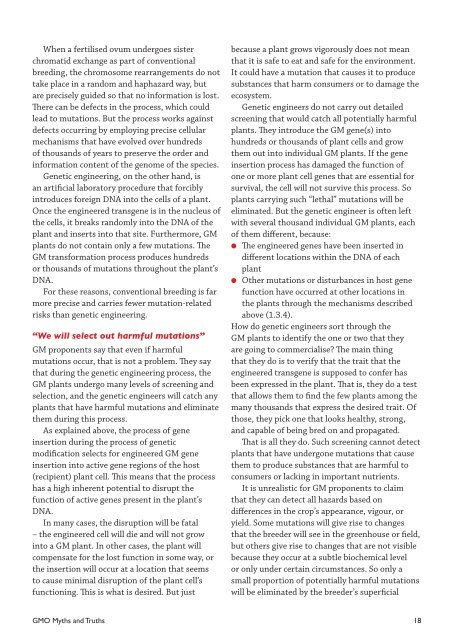GMO Myths and Truths
GMO Myths and Truths
GMO Myths and Truths
Create successful ePaper yourself
Turn your PDF publications into a flip-book with our unique Google optimized e-Paper software.
When a fertilised ovum undergoes sister<br />
chromatid exchange as part of conventional<br />
breeding, the chromosome rearrangements do not<br />
take place in a r<strong>and</strong>om <strong>and</strong> haphazard way, but<br />
are precisely guided so that no information is lost.<br />
There can be defects in the process, which could<br />
lead to mutations. But the process works against<br />
defects occurring by employing precise cellular<br />
mechanisms that have evolved over hundreds<br />
of thous<strong>and</strong>s of years to preserve the order <strong>and</strong><br />
information content of the genome of the species.<br />
Genetic engineering, on the other h<strong>and</strong>, is<br />
an artificial laboratory procedure that forcibly<br />
introduces foreign DNA into the cells of a plant.<br />
Once the engineered transgene is in the nucleus of<br />
the cells, it breaks r<strong>and</strong>omly into the DNA of the<br />
plant <strong>and</strong> inserts into that site. Furthermore, GM<br />
plants do not contain only a few mutations. The<br />
GM transformation process produces hundreds<br />
or thous<strong>and</strong>s of mutations throughout the plant’s<br />
DNA.<br />
For these reasons, conventional breeding is far<br />
more precise <strong>and</strong> carries fewer mutation-related<br />
risks than genetic engineering.<br />
“We will select out harmful mutations”<br />
GM proponents say that even if harmful<br />
mutations occur, that is not a problem. They say<br />
that during the genetic engineering process, the<br />
GM plants undergo many levels of screening <strong>and</strong><br />
selection, <strong>and</strong> the genetic engineers will catch any<br />
plants that have harmful mutations <strong>and</strong> eliminate<br />
them during this process.<br />
As explained above, the process of gene<br />
insertion during the process of genetic<br />
modification selects for engineered GM gene<br />
insertion into active gene regions of the host<br />
(recipient) plant cell. This means that the process<br />
has a high inherent potential to disrupt the<br />
function of active genes present in the plant’s<br />
DNA.<br />
In many cases, the disruption will be fatal<br />
– the engineered cell will die <strong>and</strong> will not grow<br />
into a GM plant. In other cases, the plant will<br />
compensate for the lost function in some way, or<br />
the insertion will occur at a location that seems<br />
to cause minimal disruption of the plant cell’s<br />
functioning. This is what is desired. But just<br />
because a plant grows vigorously does not mean<br />
that it is safe to eat <strong>and</strong> safe for the environment.<br />
It could have a mutation that causes it to produce<br />
substances that harm consumers or to damage the<br />
ecosystem.<br />
Genetic engineers do not carry out detailed<br />
screening that would catch all potentially harmful<br />
plants. They introduce the GM gene(s) into<br />
hundreds or thous<strong>and</strong>s of plant cells <strong>and</strong> grow<br />
them out into individual GM plants. If the gene<br />
insertion process has damaged the function of<br />
one or more plant cell genes that are essential for<br />
survival, the cell will not survive this process. So<br />
plants carrying such “lethal” mutations will be<br />
eliminated. But the genetic engineer is often left<br />
with several thous<strong>and</strong> individual GM plants, each<br />
of them different, because:<br />
● The engineered genes have been inserted in<br />
different locations within the DNA of each<br />
plant<br />
● Other mutations or disturbances in host gene<br />
function have occurred at other locations in<br />
the plants through the mechanisms described<br />
above (1.3.4).<br />
How do genetic engineers sort through the<br />
GM plants to identify the one or two that they<br />
are going to commercialise? The main thing<br />
that they do is to verify that the trait that the<br />
engineered transgene is supposed to confer has<br />
been expressed in the plant. That is, they do a test<br />
that allows them to find the few plants among the<br />
many thous<strong>and</strong>s that express the desired trait. Of<br />
those, they pick one that looks healthy, strong,<br />
<strong>and</strong> capable of being bred on <strong>and</strong> propagated.<br />
That is all they do. Such screening cannot detect<br />
plants that have undergone mutations that cause<br />
them to produce substances that are harmful to<br />
consumers or lacking in important nutrients.<br />
It is unrealistic for GM proponents to claim<br />
that they can detect all hazards based on<br />
differences in the crop’s appearance, vigour, or<br />
yield. Some mutations will give rise to changes<br />
that the breeder will see in the greenhouse or field,<br />
but others give rise to changes that are not visible<br />
because they occur at a subtle biochemical level<br />
or only under certain circumstances. So only a<br />
small proportion of potentially harmful mutations<br />
will be eliminated by the breeder’s superficial<br />
<strong>GMO</strong> <strong>Myths</strong> <strong>and</strong> <strong>Truths</strong> 18


